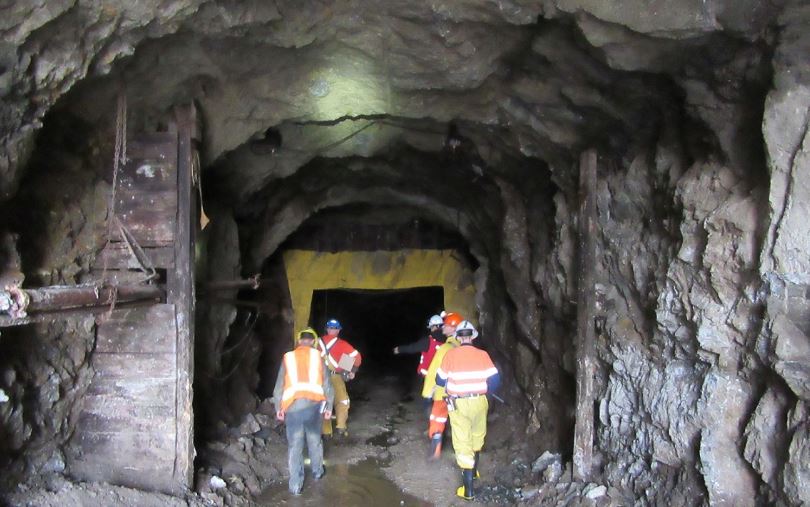Skeena intersects 16.64 g/t gold over 5.10 metres at Snip

The Snip gold mine's 440 Portal vent door. Source: Skeena Resources Ltd.
Skeena Resources Ltd. [SKE-TSXV; SKREF-OTCQX] on Thursday January 9 released the remaining analytical results from the 2019 Phase 1 surface exploration project at the former Snip gold mine in northwestern British Columbia.
The 2019 exploration program consisted of 10 surface drill holes and (1,934 metres), which were designed to test the 200 Footwall Corridor.
Highlights from Phase 1 include drill hole S19-035, which intersected a new zone of high-grade gold mineralization averaging 16.64 g/t gold over 5.10 metres, including two sub-intervals grading 96.20 g/t gold over 0.50 metres and 39.80 g/t gold over 0.85 metres in the 200 Footwall.
The company said this zone is located 100 metres vertically below surface and 370 metres east of the recently reported Phase 1 200 Footwall discovery intercept which graded 1,131.91 g/t (36.39 oz/ton) over 1.50 metres (drill hole S19-044).
The area surrounding the new zone is open down-dip and down plunge, the company said in their press release Thursday.
Skeena shares advanced on the news, rising 6.3% or $0.05 to 84 cents. The shares are currently trading in a 52-week range of 27 cents and 86 cents.
Skeena is bidding to revive two of Canada’s most successful high-grade precious metal mines – Snip and Eskay Creek.
Skeena’s former Chairman Ron Netolitzky was involved in the discovery of the Eskay and Snip mines and was named Canadian prospector of the year back in 1990. Both are located in northwest British Columbia in an area known as The Golden Triangle.
Skeena acquired a 100% interest in the former Snip Mine in July, 2017 from Barrick Gold Corp. [ABX-TSX; GOLD-NYSE]. Six months later, it secured an option to acquire a 100% stake in Eskay Creek from Barrick.
The former Snip Mine was a high-grade mine that produced approximately one million ounces of gold from 1991 to 1999, at an average gold grade of 25 g/t at a 12 g/t reserve cut off.
Approximately 60% of the production was obtained from the Twin Zone, a 0.5 to 15-metre-wide sheared quartz-carbonate-sulphide vein system that cuts through a massively bedded felspathic greywacke-siltstone sequence. Other sub parallel structures located in the footwall to the Twin Zone accounted for the rest of the production.
Situated 200 metres below the Twin Zone, the 200 Footwall has been interpreted as a parallel, en echelon structure which is geologically and structurally analogous to, and contains mineralization that is similar to the Twin Zone.
Snip was historically burdened with the high cost of being a stand-alone, fly-in-fly out, operation that was dependent on diesel fuel. Concentrates were transported from the site by hovercraft in the summer and by plane in the winter.
However, the prospects for redeveloping the Snip property have improved dramatically due to substantially higher gold prices, subsequent improvements in infrastructure and access and exploration upside, the company has said.
Skeena has said it sees the opportunity to re-examine historic drill intercepts that may indicate mineralization that would be economic due to the construction of nearby infrastructure and the higher gold price.
The 2019 Phase 1 drilling was designed to validate an isolated, historical and incompletely sampled high grade intersection in the 200 Footwall Corridor. The original target in the 200 Footwall was identified by 1997 underground drill hole UG-2610, which intersected 26.83 g/t gold over 34 metres in an incompletely sampled zone.
The recent intercept in drill hole S19-044 discovered a new occurrence of very high-grade mineralization, including a significant subinterval containing abundant visible gold, grading 3,390.00 g/t gold over 0.50 metres.
On Thursday, Skeena said the high-grade intersection in drill hole S19-044 occurred at a depth of 249.60 metres. Additional results from this drill hole include 12.60 g/t gold over 0.50 metres and 7.41 g/t gold over 0.60 metres, occurring at 242.35 metres and 214.80 metres respectively.
The company said Phase 1 drill hole S19-043 was completed prior to the newly discovered mineralization in drill hole S19-044 and intersected anomalous gold grades associated with sheared veining, including 12.00 g/t gold over 1.35 metres. “Recently completed modelling of the 200 Footwall mineralization indicates that this hole did not extend deep enough to adequately test the 200 Footwall and will be deepened during the next phase of drilling at Snip.
